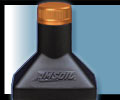Series 600 DOT 4 Racing Brake Fluid
Boiling Points
As the brake system heats up, brake
fluids with low boiling points begin to vaporize.
The brake pedal must travel further to apply the same
amount of force on the brakes, causing a spongy feeling.
If enough of the brake fluid vaporizes, brake system
failure may occur. Brake fluid boiling points are
measured on two separate scales:
- Dry equilibrium reflux boiling
point (ERBP) - the boiling point of new, freshly-opened,
unused fluid.
- Wet ERBP - the boiling point
of a brake fluid after it has absorbed three percent
water.
The minimum dry ERBP for DOT 4 brake
fluid is 230°C (446°F), while the minimum
wet ERBP is 155°C (311°F). Their higher boiling
points make DOT 4 fluids appropriate for high-performance
cars and motorcycles and for vehicles used for towing
or in mountainous regions.
AMSOIL Series 600 DOT 4 Racing Brake
Fluid is formulated with the best zinc-based anti-corrosion
additives and pH stabilizers. It is designed for high-temperature
stability, yet flows easily at low temperatures. AMSOIL
Series 600 Racing Brake Fluid's superior additive
package provides good lubrication throughout the system
and can raise boiling points to more than 232°C
(450°F). It keeps water in suspension, slowing
its effects on the brake system. AMSOIL Brake Fluids
have high boiling temperatures, ensuring maximum life
and reliable braking power, even in extreme conditions.
AMSOIL Series 500 High- Performance DOT 3 Brake Fluid
has a dry ERBP of 274°C (525°F) and wet ERBP
of 156°C (313°F). AMSOIL Series 600 DOT 4
Racing Brake Fluid has a dry ERBP of 304°C (580°F)
and wet ERBP of 210°C (410°F).
Compressibility
When a fluid is non-compressible
it means it won’t compress into a smaller volume
when pressure is applied. In a brake system, fluid
pressure is multiplied by the master cylinder and
can reach more than 1,000 pounds per square inch (psi)
in the lines. Like any other hydraulic fluid, brake
fluid must be non-compressible at the expected pressures
to transmit force from one end of the system to the
other while simultaneously lubricating the pistons
and rubber parts as they move through their bores.
If the fluid were to compress, all braking power would
be lost. AMSOIL Series 600 DOT 4 Racing Brake Fluid
remains non-compressible, even at the highest pressures
generated in automotive brake systems. AMSOIL Brake
Fluid provides superior stopping ability under the
most demanding conditions.
Brake Fluid Maintenance
Brake fluids fail either because
they boil or because they cease to provide adequate
lubrication and corrosion protection. Both reasons
for failure are the result of contamination, usually
by water or petroleum products.
DOT 3 and DOT 4 polyglycol ether-based
brake fluids are hygroscopic, which means they absorb
water easily and hold it in suspension, similar to
antifreeze. In most climates, moisture seeps into
the brake system continuously through the various
seals and microscopic pores of the flexible brake
lines. This seepage can accelerate as a vehicle ages
and there’s almost no limit to how much water
the fluid can absorb. By the time brake fluid has
been in the system for three years, it can easily
reach its wet boiling point. Because this happens
gradually, most drivers won’t discover the reduced
braking ability until it’s too late.
Many owner’s manuals recommend
changing brake fluid every 24 months to remove moisture.
Approximately half of all cars and light trucks in
the U.S. over 10 years old have never had the brake
fluid changed. In addition, powersports applications
such as motorcycles, ATVs and UTVs require routine
brake fluid changes as well.
|



